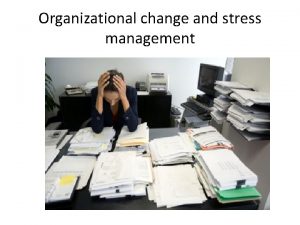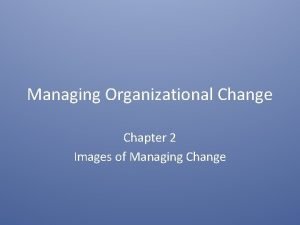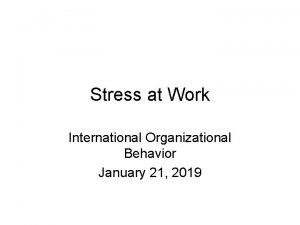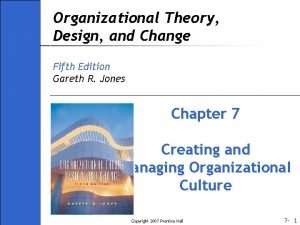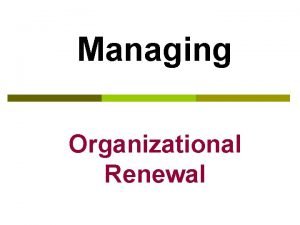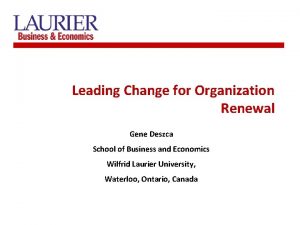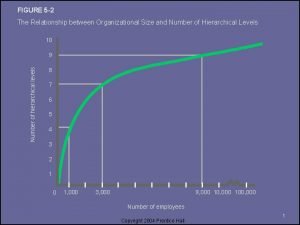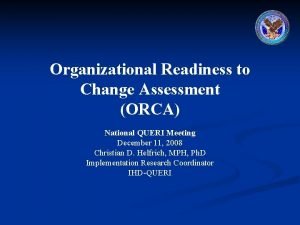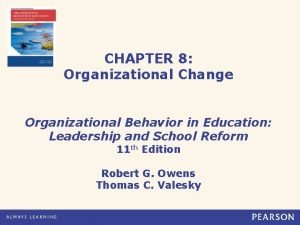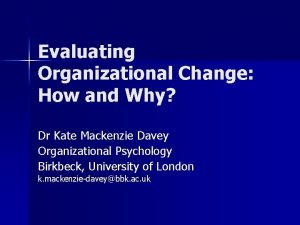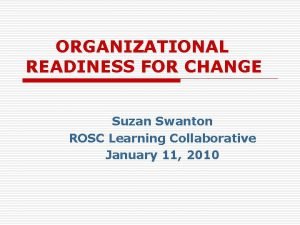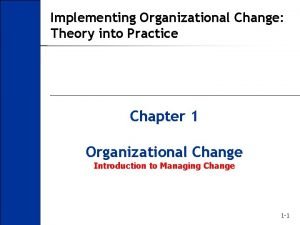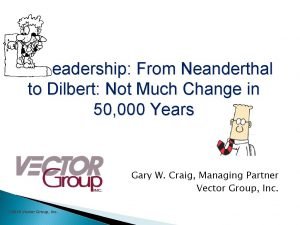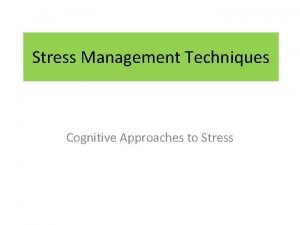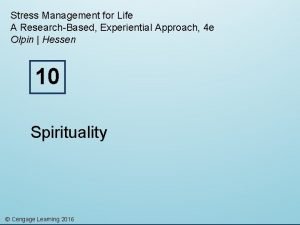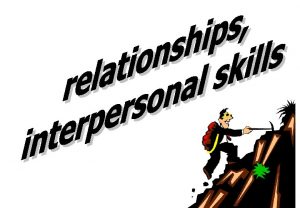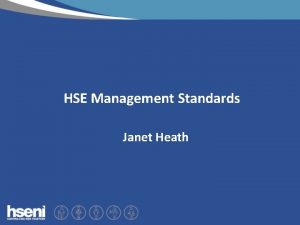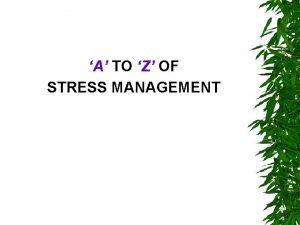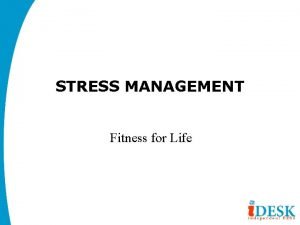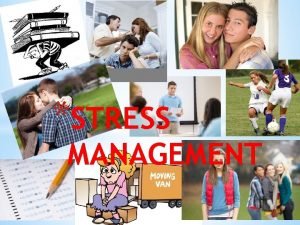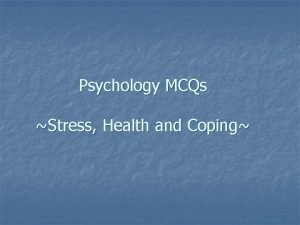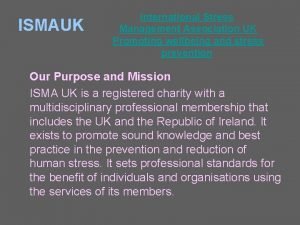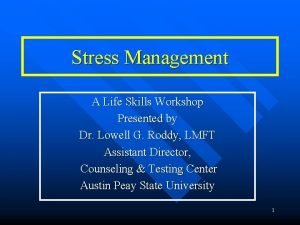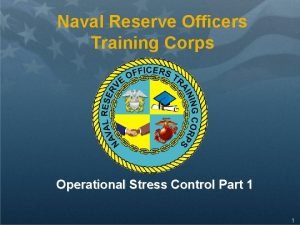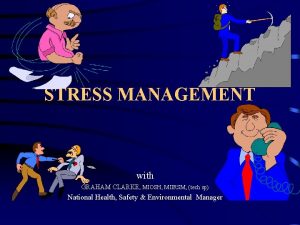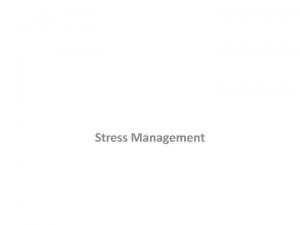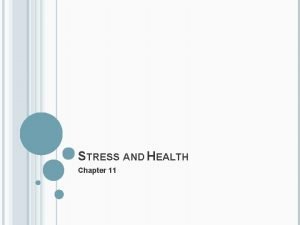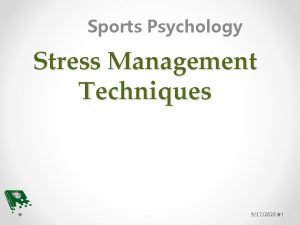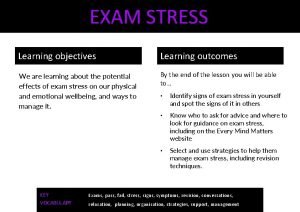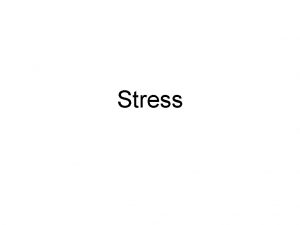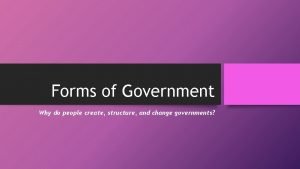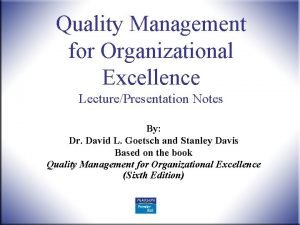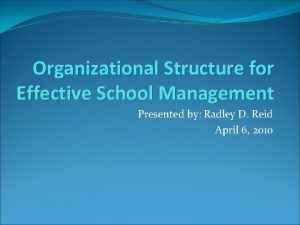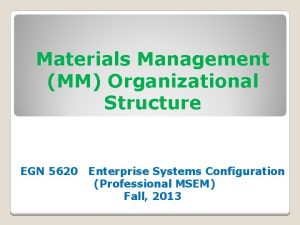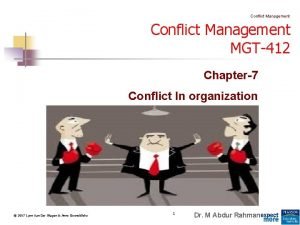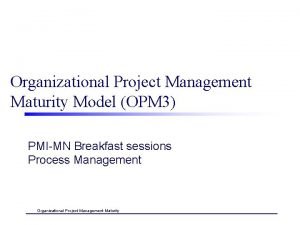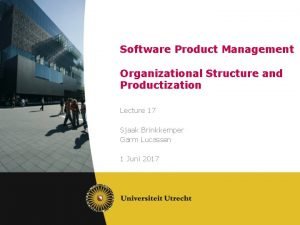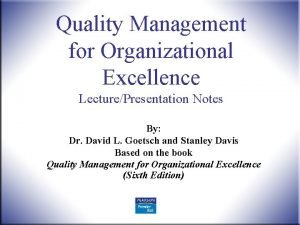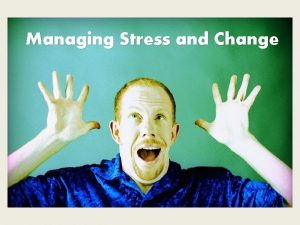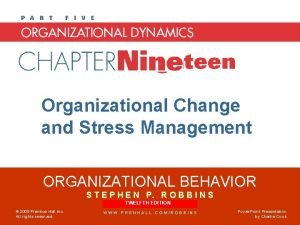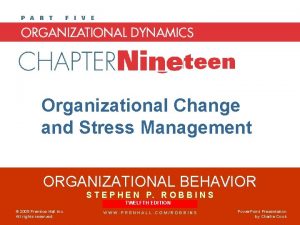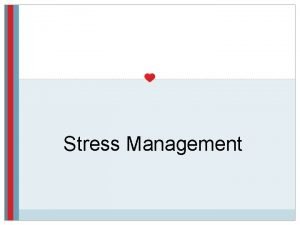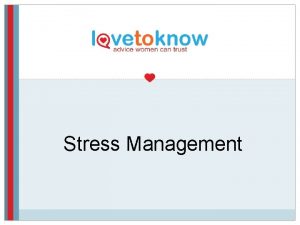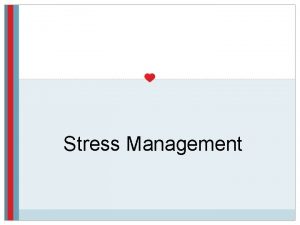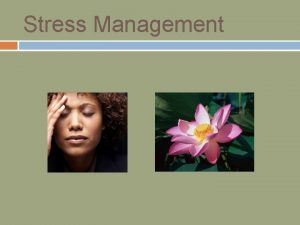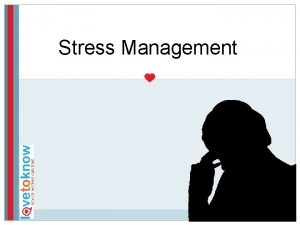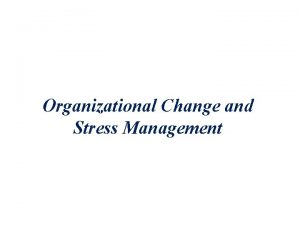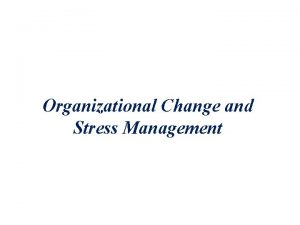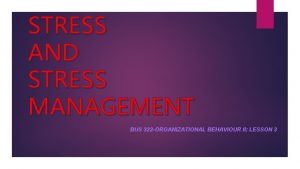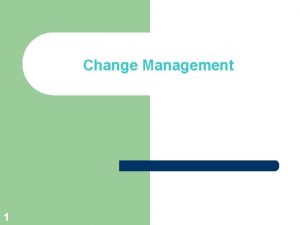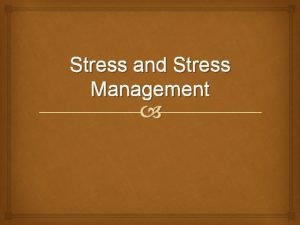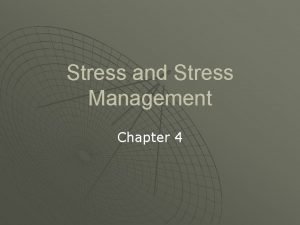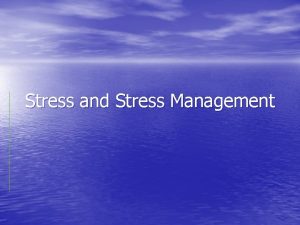Organizational change and stress management Why change is
























































- Slides: 56

Organizational change and stress management

Why change is so important? • Only organisations that are able to change survive • CHANGE OR PERISH

Forces for change • • • Changing nature of the workforce Changing technology Economic shocks Competition Changing social trends World politics

Changing nature of the workforce • Employees differ in their nationalities, gender, age, education, race, talent, ethnicity, sexual orientation, lifestyle and values

Changing technology • Rapid change • Most modern technology gets outdated in no time

Economic shocks • Economic meltdown and financial crisis has lead to the bankruptcy of many organisations

Competition • Now it is global competition across borders • Only continuous innovation can ensure survival

Changing social trends • Consumers and employees are more demanding • Consumers are able to give the feedback through blogs and chat rooms.

World politics • Changes in government can pose new challenges

Organizational stress • Stress is an inevitable part of modern day life • Organizational stress is a major concern as it can have damaging physiological and psychological effects on people working there.

What is stress? • An unpleasant psychological process that occurs in response to environmental pressures

Stress facts • • Is not always negative Challenge versus hindrance stressors Commitment and stress Demands and resources

Stress is not always negative • Stress improves performance

Challenge versus hindrance stressors • Pressure to complete work on time or extra work load (challenge stressors) • Stressors that prevent a person from reaching the goal (hindrance stressors) • Hindrance stressors more harmful than challenge stressors

Commitment and stress • Employees with high levels of affective commitment (positive feelings) tend to improve their performance with stress

Demands and resources • Stress= demands>resources • Demands- duties, obligations, pressures, expectations or uncertainties • Resources- things that are under an individual’s control

Sources/causes of stress • 3 sources • Environmental stressors • Organizational stressors • Personal stressors



Environmental stressors • Economic uncertainty • Political uncertainty • Technological uncertainty

• Economic uncertainty- bad economy causes stress • Political uncertainty- less stress when the political climate is stable • Technological uncertainty- rapid advances in technology pose a threat

Organizational stressors 1) Task demands 2) Role demands a) Role conflict b) Role overload c) Role ambiguity 3) Interpersonal demands

• Task demands- level of autonomy, degree of task variety, working conditions, assembly line pressures, overcrowded working conditions, poor lighting , noise, demanding customer service etc. • Interpersonal demands- no cordial relationship with coworkers, superiors and subordinates. Bullying, sexual harassment, physical fights, racial discrimination

• Role demands- every employee has a particular role to play. Role demands that cause stress are 1) Role conflict- arises when different people have different expectations 2) Role overload- occurs when individuals are asked to do more 3) Role ambiguity- no clarity regarding work, duties and responsibilities.

Personal stressors • Family problems • Financial problems • personality

• Family problems- quarrel between husband wife or illness in family. Strained relationship between spouses, physically/mentally disabled children • Financial problems- accommodation and standard of living high. Dual career coupleless time for family. Poor money management. • Personality- some are more prone to stress

Individual and cultural differences in the experience of stress

Individual differences • 1) Perception- how an employee looks at a situation • How an employee interprets the situation will decide whether he will experience stress.

• 2) job experience- negative relationship between job experience and job stress. Two reasons a) Selective withdrawalhigher stress more chances for quitting work b) Coping mechanismpeople develop coping mechanisms when exposed to stress for a long time

• 3) social support from coworkers can ease stress

• 4) personality- high on neuroticism stress more. • Workaholic employees experience more stress 1) They are obsessed with work 2) Put in long hours at work 3) Continuously think about work 4) Take more responsibility

Cultural differences Country Cause of stress United states No adequate control over their jobs China Job evaluation and lack of training US, UK, Canada (individualistic cultures) More stress when work interferes family life Collectivistic cultures doing additional work is seen as a sacrifice for the family. No difference in the experience of stress across cultures due to personality traits

Effects of stress • Physiological effects • Psychological effects • Behavioral effects

Physiological effects • • Upper respiratory illnesses Poor functioning of the immune system Heart diseases Hypertension High cholesterol Ulcers Arthritis Frequent colds, fever

Psychological effects • • • Job dissatisfaction Anxiety Tension Boredom Depression Irritability Laziness Lower emotional well being Frequent mood changes Loss of self esteem Inability to concentrate on work Inability to make decisions

• Psychological effects are more on jobs where 1) employee’s work lack clarity 2) Little autonomy 3) Little job variety 4) Lack of feedback 5) Lack of sense of identity

Behavioral effects • • • Reduced productivity Absenteeism Employee turnover Changes in eating habits Sleep disorders Excessive drinking Drug addiction Excessive smoking Poor interpersonal relations Stammering

Relationship between stress and performance

Coping with stress • Stress can have positive and negative effects • Management of stress can be done at individual and organizational level

Individual approaches to stress management • • Better time management Physical exercises Relaxation training Expanding social support networks

1) Better time management • Prepare a list of activities to be completed • Prioritizing activities • Scheduling activities based on priority • Awareness of one’s daily schedule and doing the most demanding activities when one is most alert • Avoid distraction such as chatting or browsing

2) Physical exercises • Aerobics, swimming, jogging, cycling

3) Relaxation training • Meditation • Hypnosis • Deep breathing

4) Expanding social support networks • Social support from friends, family and coworkers • Close friends are extremely helpful

Other individual measures • Taking a break from work • Telling the superior that one is stressed • Detaching oneself mentally from work when physically away from work

Organizational approaches to stress management • • • Proper selection and placement Training Goal setting Job redesign Reduction of role conflict and role ambiguity Greater employee participation Effective communication Sabbaticals Wellness programs

Proper selection and placement • Careful selection of employees can reduce stress • Stress levels of different jobs are different – hiring people with experience

Training • Training current employees and those who are underperformers can reduce stress

Goal setting • Goals which are specific, challenging and provide feedback reduce stress • Well defined goals reduce uncertainty

Job redesign • Redesign helps to give better control on jobs • Job enlargement and job enrichment play a major role in reducing stress

Reduction of role conflict and role ambiguity • Clear description of roles can reduce ambiguity

Greater employee participation • Participations creates the feeling of empowerment

Effective communication • Open communication reduces stress

Sabbaticals • Employees may be given a break when needed • Employees come back refreshed, more creative and energetic

Wellness programs • Workshops on quit smoking, reduce alcohol consumption, healthy food habits and healthy life style can contribute to overall health of the employee

Summary • • Organisational change Forces for change Stress Causes of stress Difference in stress perception Effects of stress Coping with stress
 Organizational change and stress management
Organizational change and stress management Chapter 10 stress responses and stress management
Chapter 10 stress responses and stress management Andreas carlsson bye bye bye
Andreas carlsson bye bye bye Change and stress management
Change and stress management True
True Normal stress
Normal stress Images of managing change
Images of managing change What is stress in organizational behavior
What is stress in organizational behavior Dont ask why why why
Dont ask why why why Organizational theory design and change
Organizational theory design and change Leading change and organizational renewal
Leading change and organizational renewal Leading change and organizational renewal
Leading change and organizational renewal What is organization
What is organization Why buccal shelf area is stress bearing area
Why buccal shelf area is stress bearing area Motivation and stress management
Motivation and stress management Information resources
Information resources Organizational theory and management
Organizational theory and management Change adalah
Change adalah Development change adalah
Development change adalah Organizational readiness to change assessment
Organizational readiness to change assessment Organizational change in schools
Organizational change in schools Implementing organizational change spector
Implementing organizational change spector Evaluating organizational transformation
Evaluating organizational transformation Organizational readiness for change maryland
Organizational readiness for change maryland Implementing organizational change theory into practice
Implementing organizational change theory into practice Change management dilbert
Change management dilbert Cognitive stress management techniques
Cognitive stress management techniques Objectives of stress management
Objectives of stress management Stress management for life
Stress management for life Stress management life skills
Stress management life skills Stress management jeopardy
Stress management jeopardy Hse stress management standards
Hse stress management standards Thesis statement about stress
Thesis statement about stress Stress management vocabulary
Stress management vocabulary Abc stress management
Abc stress management Stress management for life 5th edition
Stress management for life 5th edition Stress management explanation
Stress management explanation Stress management objectives
Stress management objectives Stress management paragraph
Stress management paragraph Health psychology mcqs
Health psychology mcqs International stress management association
International stress management association Stress management life skills
Stress management life skills Stress continuum
Stress continuum Abc strategy of stress management
Abc strategy of stress management Individual approaches to stress management
Individual approaches to stress management Conclusion of stress management
Conclusion of stress management Stress management objectives
Stress management objectives Learning objectives for stress management
Learning objectives for stress management Learning objectives for stress management
Learning objectives for stress management Why do people create structure and change governments
Why do people create structure and change governments Quality management for organizational excellence
Quality management for organizational excellence Organizational structure for a school
Organizational structure for a school Materials management organizational structure
Materials management organizational structure Structual conflict
Structual conflict Opm 3
Opm 3 Software product lines
Software product lines Quality management for organizational excellence
Quality management for organizational excellence



